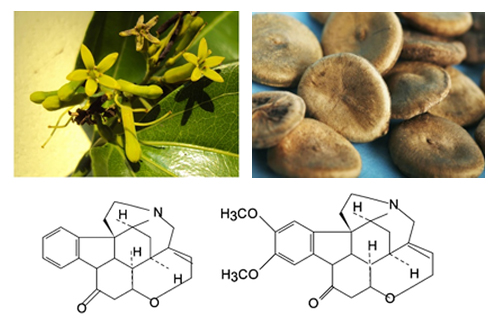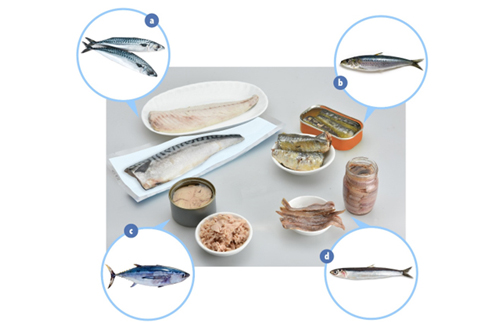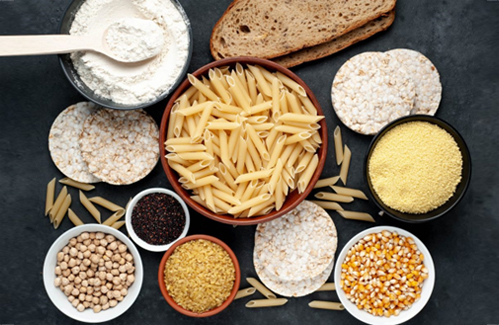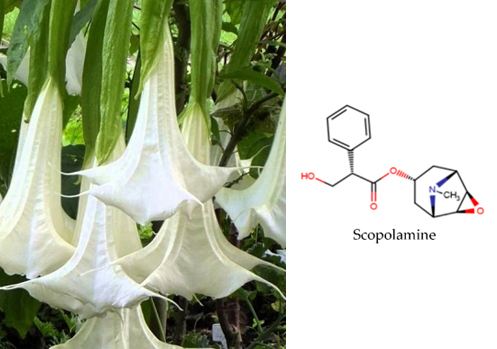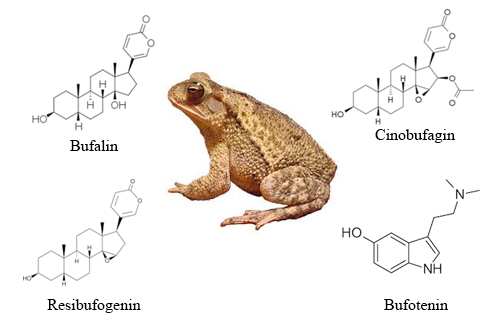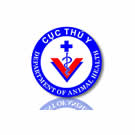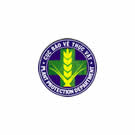- Folder Determine Cause of Poisoning
- Views 2190
- Last Updated 01/06/2023
In Vietnamese oriental medicine, Phytolaccaceae sp. is classified as a low-grade medicine with a healing effect but toxicity. Many poisoning cases have been hospitalized and even died after using this plant without a doctor's instructions.
Phytolaccaceae sp. (Vietnamese name is “Thuong Luc”) is a medicine used for a long time in traditional Vietnamese oriental medicine with the use of diuretics, cholera, moist lobes in viscera. Although the roots of the plant have many uses, they are toxic, so they are classified as low-grade. Recently, in some places, people have found that the tuber-shaped roots are a bit like a human being confused with ginseng, so it is used as a tonic with the name "Korean ginseng". In recent years, the National Institute for Food Control has determined the cause of many poisoning cases related to Phytolaccaceae sp. and participated in communication activities for health workers and people in order to prevent poisoning of Phytolaccaceae sp..
1. The situation of Phytolaccaceae sp. related food poisoning in Vietnam
In recent times, many localities have reported food poisoning related to Phytolaccaceae sp.. During 2020-2023, the National Institute for Food Control has received a number of reports of Phytolaccaceae sp. related food poisoning, as well as analysis to determine the cause as follows:
In February 2020, a report from Ke Nam village, Chau Binh commune, Quy Chau district, Nghe An province, a case of food poisoning occurred after a meal of twelve people, during the meal there were six people drinking alcohol, five people had symptoms of poisoning, four people went to the hospital, one person showed symptoms of nausea and vomiting, did not go to the hospital. The analysis results of the National Institute for Food Control have determined that the species in the root sample of a forest tree of unknown origin used to soak wine is a plant belonging to the genus Phytolacca acinosa and detected typical toxic substances in Phytolaccaceae sp., includes phytolaccagenin and phytolaccatoxin.
In May 2020, it was reported from Cho Don district, Bac Kan province, that there was one case of food poisoning caused by drinking alcohol soaked with tree roots, three people with symptoms of nausea, vomiting, and diarrhea. The analysis results of the National Institute for Food Control determined that the species in the wine samples soaked in tubers and roots was a plant belonging to the genus Phytolacca esculenta and detected typical toxic substances in Phytolaccaceae sp. including phytolaccagenin and phytolaccatoxin.
In June 2021, a case from Hoa Binh Provincial General Hospital reported that five patients were admitted to the hospital with similar symptoms such as numbness of the tongue, severe abdominal pain, vomiting, diarrhea, sweating, shortness of breath, etc. Drink wine soaked with the tubers of a plant they say is ginseng. Analytical results of the National Institute for Food Control in the sample of pickled wine found a typical toxic substance in Phytolaccaceae sp., which is phytolaccatoxin.
In January 2023, a report from Lec village, Po Y commune, Ngoc Hoi district, Kon Tum province of Ngoc Hoi district Health Center and Kon Tum Provincial Food Safety and Hygiene Department, about a household of 05 poisoned people after meals, including wild vegetables, were identified as leaves of Phytolaccaceae sp. with symptoms of nausea, vomiting, diarrhea, fatigue, headache, tremor, and a symptomatic case with chest tightness, shortness of breath were given immediate emergency treatment.
In April 2023, in Nho Trong village, Tri Quang commune, Bao Thang district, Lao Cai province, a food poisoning incident occurred after a meal of eleven people, during the meal, two people drank white wine, three people drank soaked wine Phytolaccaceae sp. tubers grown by the family. The three people drank alcohol-soaked Phytolaccaceae sp. with symptoms: headache, dizziness, nausea, vomiting, loose stools accompanied by blurred vision, and no deaths. The test results of the National Institute for Food Control showed that the wine samples soaked in Phytolaccaceae sp. tubers and Phytolaccaceae sp. tubers collected from the meal by Bao Thang District Health Center both detected phytolaccatoxin toxins.
Phytolaccaceae sp. poisoning occurs mainly because people confuse it with other edible plants, mainly ginseng.
2. Characteristics, distribution, and poisonous symptoms
2.1. Characteristics and distribution:
Phytolaccaceae sp. is also known as, “Thuong luc nho”, “Son la bac”, “Truong bat lao”, “Kim That Nuong”, “ Bach mau ke” or “Da la bac”, there are two common species in Vietnam with the scientific names Phytolacca esculenta Van Hout and Phytolacca acinosa belonging to Phytolaccaceae family.
Plant description: herbaceous, perennial, more than 1m tall. Stems smooth, hairless, cylindrical or slightly rounded with greenish or slightly reddish-purple edges. Leaves simple, whole, with peduncles, alternately, leaf blade round ovate, pointed tip, margin whole, 2 leaf surfaces smooth, 10-38 cm long, 13-14 cm wide. Inflorescences cluster, 15-20 cm long, consisting pattern of five white flowers. Berries, flattened globose with 8-10 segments, with an existing style, purplish-black or purple-black when ripe. The slightly anthropomorphic root is easily confused with ginseng.
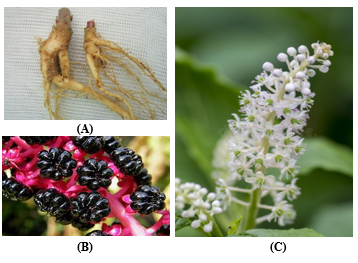
Figure 1. Some parts of the plant: (A) – Root; (B) – Fruit; (C) – Flowers
Phytolaccaceae sp. originated in China and migrated to Vietnam about ten years ago. Currently, this plant is grown in some places in our country but the quantity is not much, distributed mainly in mountainous provinces with an altitude of 700 - 1600 m, such as Sa Pa, Muong Khuong (Lao Cai), Ky Son (Nghe An), Phong Tho (Lai Chau), Quan Hoa (Thanh Hoa)...
Some plants are easily confused with Phytolaccaceae sp.: Ginseng
Table 1. Phytolaccaceae sp. is easily confused with Ginseng
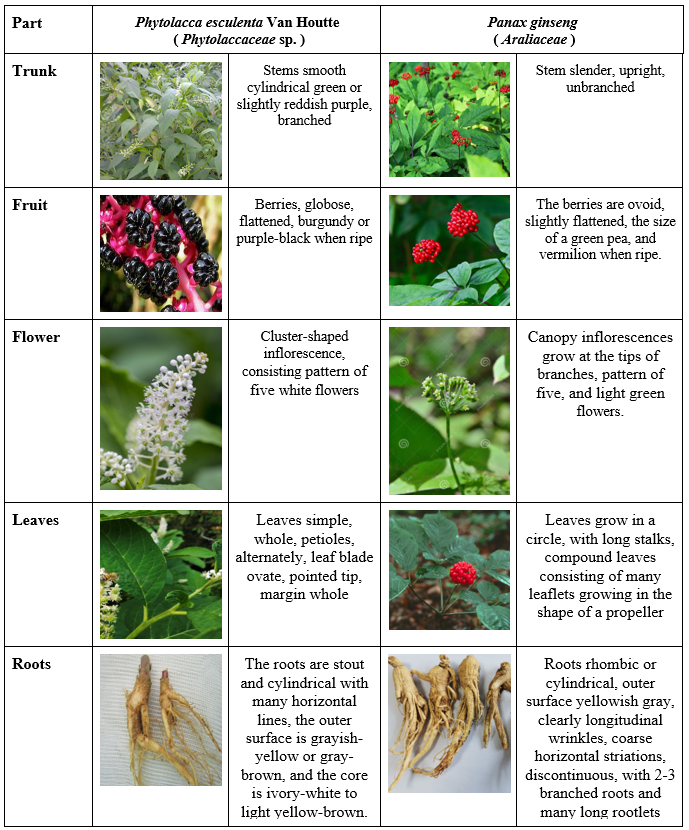
2.2. The toxin in Phytolaccaceae sp.
Most parts of the plant contain toxins phytolaccatoxins, saponins triterpenes esculentosides A, B, H, I, L, K, M
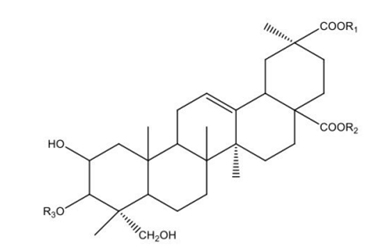
Figure 2. Typical toxin of Phytolaccaceae sp.
R1=CH3; R2=R3=H : phytolaccagenin
R1=CH3; R2=H; R3=-xyl : esculentoside B (Phytolaccoside B)
According to some documents on medicinal plants in Vietnam, Phytolaccaceae sp. has many medicinal uses, but it is toxic, so it should be used with caution when used in combination. The main effect of the toxin on the saponin group is to cause strong mucosal irritation. When eating lightly, the mouth, and tongue, vomiting, severe abdominal pain, severe convulsions, and coma.
2.3. Symptoms of poisoning
Symptoms of poisoning appear after about twenty minutes to three hours after eating/drinking.
Symptoms of poisoning: mild, increased body temperature, heart palpitations, rapid breathing, vomiting, abdominal pain, and mental panic. Severe cases cause neurological paralysis, coma, difficulty breathing, low blood pressure, and cardiac arrest causing death.
3. Prevention and treatment of poisoning caused by Phytolacca esculenta
3.1. Treatment
In case of detecting a patient with poisoning, it is necessary to notify the health agency and take the patient to the hospital promptly and treat the symptoms mainly.
Specific measures to handle poisoning are as follows:
- Absorption restriction:
+ Induce vomiting: conducted when the patient has just finished eating, the patient is awake and cooperative. Induce vomiting by mechanical means, give the patient water to drink, and then use a cotton swab or nebulizer to induce vomiting in the patient.
+ Gastric lavage: Immediately after detecting poisoning, the fastest effect is in the first 60 minutes of acute poisoning.
+ Use activated charcoal: use after inducing vomiting or gastric lavage. Do not use during a convulsion or coma.
- Symptomatic treatment: need to closely monitor signs of convulsions, heart rate, and blood pressure. Supportive treatment measures are important, there is no specific antidote.
3.2. Prevention
Phytolaccaceae sp. poisoning is often caused by confusion with ginseng, so many people use it as a tonic. Therefore, to prevent Thuong Luc poisoning, it is necessary to do the following well:
- Disseminate knowledge, avoid poisoning by mistake
- Do not arbitrarily use herbal medicine, or traditional medicine without the guidance of a doctor.
- It is recommended that people be on high alert, and do not arbitrarily pick or take the roots without knowing the toxic types to use.
4. Propaganda activities to prevent and control Thuong Luc poisoning
In recent years, the National Institute for Food Control has determined the cause of food poisoning cases related to Phytolaccaceae sp. and participated in communication activities for grassroots health workers and people to prevent Phytolaccaceae sp. poisoning. With the desire to contribute to reducing the cases of food poisoning caused by Phytolaccaceae sp. in particular and natural toxins in general, the National Institute for Food Control regularly conducts investigation and identification activities for food poisoning causes as well as poisoning prevention communication. Communication activities on the prevention of Phytolaccaceae sp. poisoning will help limit future poisoning cases. At the same time, timely test results will help confirm the cause of poisoning and help to treat doctors quickly, and take timely measures to handle cases of poisoning.
The National Institute for Food Control is the highest-level food testing agency, under the Ministry of Health, established under the Prime Minister's Decision No. 376/QD-TTg dated March 23, 2009. covered. The National Institute for Food Control is designated by the Ministry of Health, the Ministry of Agriculture and Rural Development, and the Ministry of Industry and Trade to serve as a testing agency for state management. The National Institute for Food Control is an arbitration testing unit nationwide for food quality and safety. In addition to performing food testing tasks to serve the state management in accordance with functions and duties, the National Institute for Food Control performs food testing services for customers in need. With the leading food testing capability in Vietnam, a laboratory with modern equipment, and a team of experienced staff and experts, the National Institute for Food Control is committed to bringing to customers the best service of food testing with the motto: Honesty, Devotion, Accuracy, Efficiency, Prestige.
REFERENCES
1. Đỗ Tất Lợi (2004), Những cây thuốc và vị thuốc Việt Nam, Nhà xuất bản Y học.
2. Đỗ Huy Bích (2006), Cây thuốc và động vật làm thuốc ở Việt Nam, Nhà xuất bản Khoa học và Kỹ thuật
3. Bộ Y tế (2015), Hướng dẫn chẩn đoán và xử trí ngộ độc.
4. Trần Công Khánh (2004), Cây độc ở Việt Nam, Nhà xuất bản Y học.





